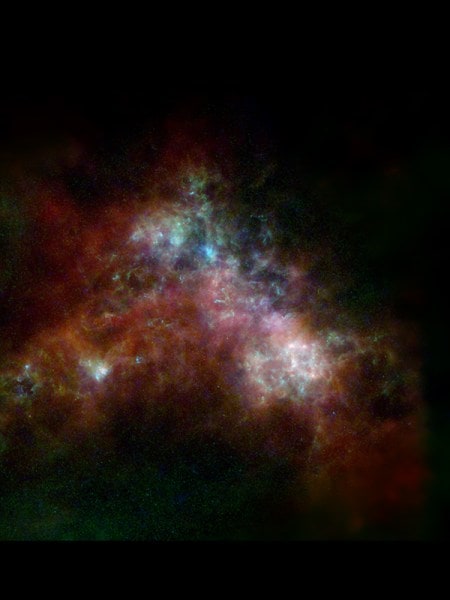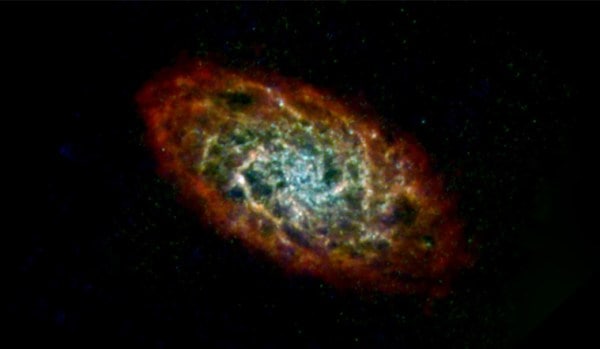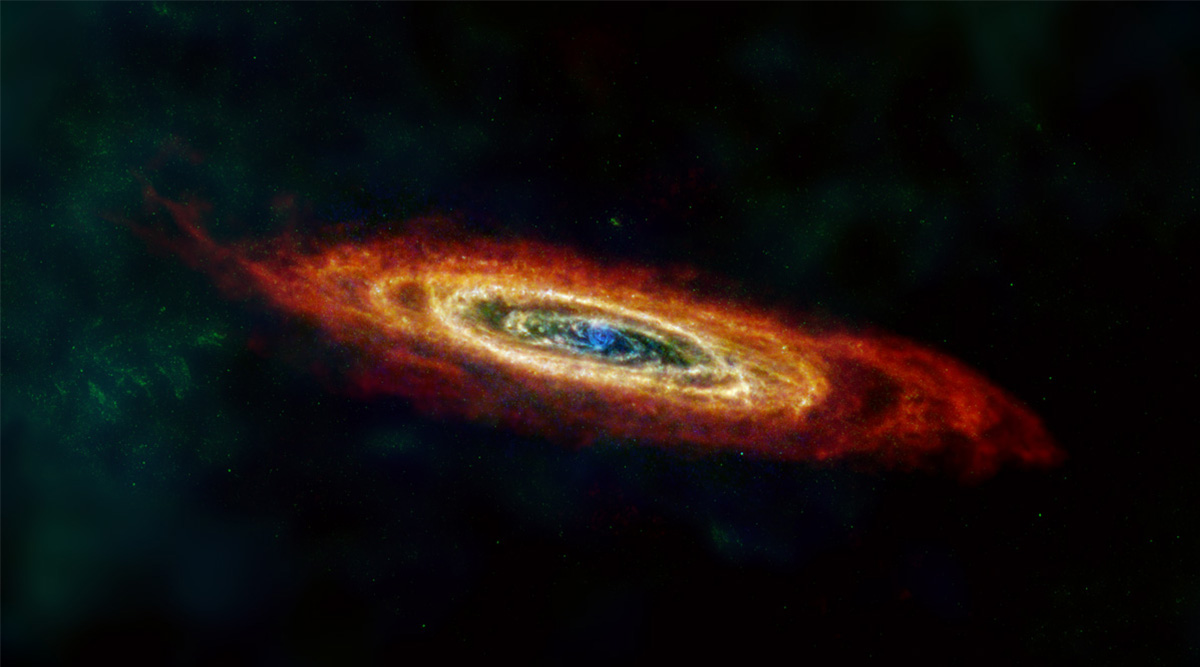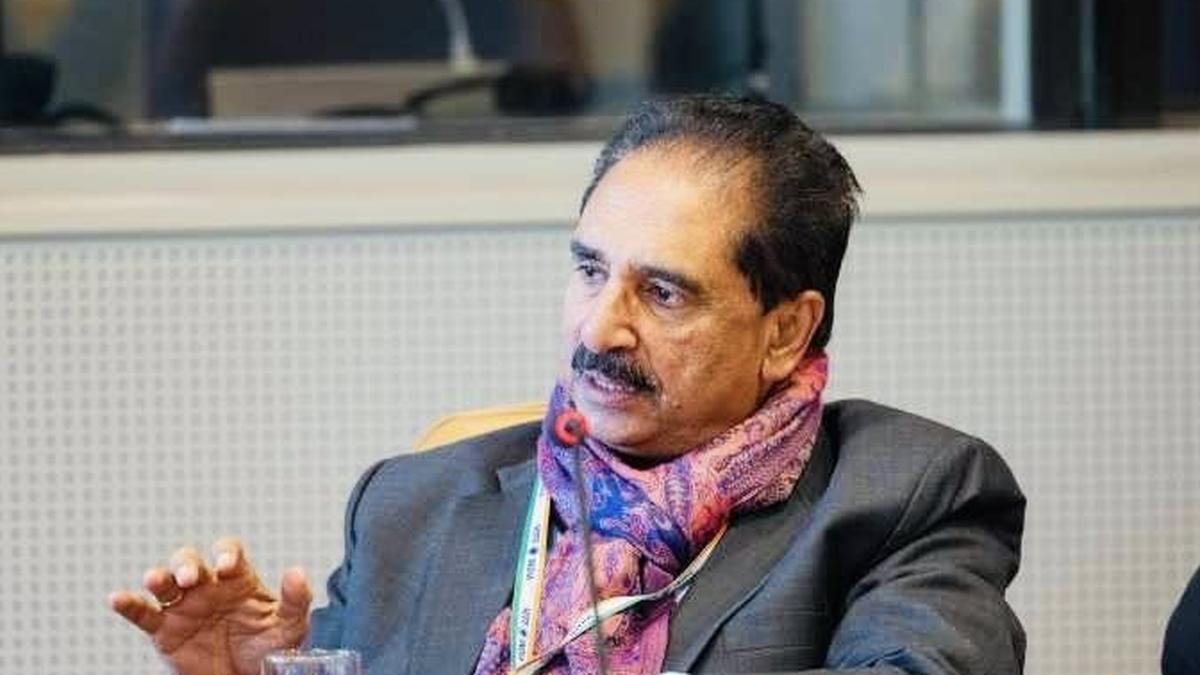New images that use data from retired ESA (European Space Agency) and NASA missions show the dust that fills the space between stars in four galaxies closest to our own Milky Way. The striking pictures also lend insights into how dramatically the density of dust clouds can vary within a galaxy.
Cosmic dust has a consistency similar to smoke. It is created by dying stars and is also the material that forms new stars. According to NASA, space telescopes observe dust clouds are constantly shaped and moulded by exploding stars, stellar winds, and the effects of gravity. It also notes that understanding this cosmic dust is key to understanding our own universe.
 The Large Magellanic Cloud is a satellite of the Milky Way, containing about 30 billion stars. Seen here in a far-infrared and radio view, the LMC’s cool and warm dust are shown in green and blue, respectively, with hydrogen gas in red. (Image credit: ESA/NASA/JPL-Caltech/CSIRO/C. Clark (STScI))
The Large Magellanic Cloud is a satellite of the Milky Way, containing about 30 billion stars. Seen here in a far-infrared and radio view, the LMC’s cool and warm dust are shown in green and blue, respectively, with hydrogen gas in red. (Image credit: ESA/NASA/JPL-Caltech/CSIRO/C. Clark (STScI))
The work of ESA’s Herschel Space Craft Observatory which operated from 2009 to 2013 made the new observations possible. The supercold instruments were able to detect the thermal glow of dust emitted as infrared light. Herschel’s images of the cosmic dust gave views of fine details in these clouds.
But the way the telescope could not detect light from more spread out and diffuse clouds, especially in the outer regions of galaxies, where the gas and dust become sparse.

 The Small Magellanic Cloud is another satellite of the Milky Way, containing about 3 billion stars. This far-infrared and radio view of it shows the cool (green) and warm (blue) dust, as well as the hydrogen gas (red). (Image credit: ESA/NASA/JPL-Caltech/CSIRO/NANTEN2/C. Clark (STScI))
The Small Magellanic Cloud is another satellite of the Milky Way, containing about 3 billion stars. This far-infrared and radio view of it shows the cool (green) and warm (blue) dust, as well as the hydrogen gas (red). (Image credit: ESA/NASA/JPL-Caltech/CSIRO/NANTEN2/C. Clark (STScI))
This meant that Herschel missed up to 30 per cent of all the light given off by dust in nearby galaxies. To fill out the gaps in the dust maps created using Herschel, astronomers used data from three retired missions: ESA’s Planck observatory and NASA’s Infrared Astronomical Satellite (IRAS) and Cosmic Background Explorer (COBE).
In the images, you can see the Andromeda galaxy(known as M31), the Triangulum galaxy (M33) and the Large and Small Magellanic Clouds, which are dwarf galaxies orbiting the Milky Way and don’t have the spiral structures of the Andromeda and Triangulum galaxies. All four of these galaxies are within three million light-years of our planet.
According to NASA’s JPL labs, the red colour in the images indicates hydrogen gas. Bubbles of empty space in the images indicate regions where stars were recently formed and blew away surrounding dust and gas due to their instant wind. The green light around the edges of the bubble indicates the presence of cold dust that has piled up as a result of those winds. Warmer dust shown in blue indicate where stars are forming and other processes that could be heating the dust.

 The Triangulum galaxy is shown here in far-infrared and radio wavelengths of light. Some of the hydrogen gas (red) that traces the edge of the Triangulum’s disc was pulled in from intergalactic space, and some was torn away from galaxies that merged with Triangulum far in the past. (Image credit: ESA/NASA/JPL-Caltech/GBT/VLA/IRAM/C. Clark (STScI))
The Triangulum galaxy is shown here in far-infrared and radio wavelengths of light. Some of the hydrogen gas (red) that traces the edge of the Triangulum’s disc was pulled in from intergalactic space, and some was torn away from galaxies that merged with Triangulum far in the past. (Image credit: ESA/NASA/JPL-Caltech/GBT/VLA/IRAM/C. Clark (STScI))
Carbon, oxygen, iron and other heavy elements can get stuck to dust grains and the presence of these different elements changes the way dust absorbs starlight. “These improved Herschel images show us that the dust ‘ecosystems’ in these galaxies are very dynamic,” said Christopher Clark, an astronomer at the Space Science Telescope Institute in Maryland, and leader of the work to create these images, in a press statement.
Scientists studying interstellar space and star formation are trying to better understand these ongoing cycles. The newly created images have shown that the dust-to-gas ratio can vary by up to a factor of 20 within a single galaxy, far more than previously estimated.
!function(f,b,e,v,n,t,s)
{if(f.fbq)return;n=f.fbq=function(){n.callMethod?
n.callMethod.apply(n,arguments):n.queue.push(arguments)};
if(!f._fbq)f._fbq=n;n.push=n;n.loaded=!0;n.version=’2.0′;
n.queue=[];t=b.createElement(e);t.async=!0;
t.src=v;s=b.getElementsByTagName(e)[0];
s.parentNode.insertBefore(t,s)}(window, document,’script’,
‘https://connect.facebook.net/en_US/fbevents.js’);
fbq(‘init’, ‘444470064056909’);
fbq(‘track’, ‘PageView’);






